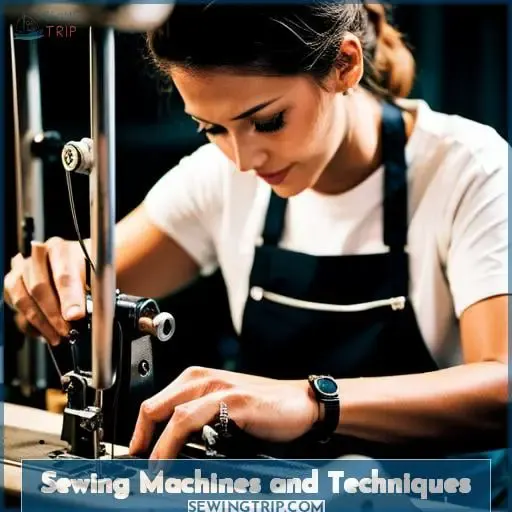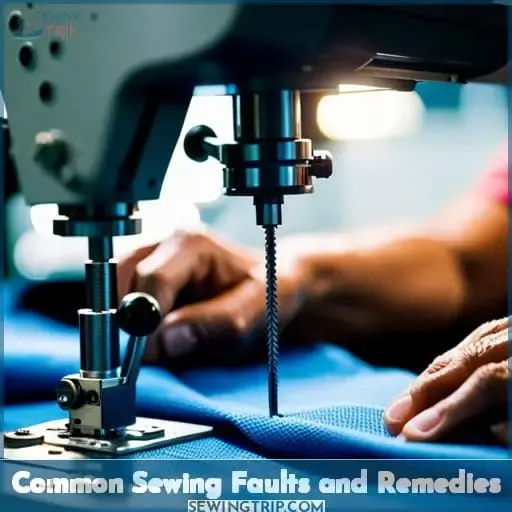This site is supported by our readers. We may earn a commission, at no cost to you, if you purchase through links.
Welcome to the world of sewing! This craft has been around for centuries and is still going strong in today’s garment industry. As you dive into this fascinating field, you’ll find an amazing array of fabrics, techniques, machines, and skills that will leave your head spinning.
From creating intricate embellishments to constructing garments from scratch – it all starts with a needle and thread in the hands of a talented sewer. Sewing departments play an essential role in producing quality clothing pieces. They are responsible for ensuring accuracy while carefully crafting each item according to exact specifications.
By using skillful precision along with specialized machinery, sewers can transform ordinary materials into beautiful works of art – so let’s explore what goes on behind-the-scenes at these creative hubs!
Table Of Contents
Key Takeaways
- Sewing is a crucial department in the garment industry that plays a vital role in producing quality clothing pieces and ensuring accuracy.
- Different types of sewing machines are required for various processes, and understanding thread selection, seam allowance, and fabric choice is crucial for producing high-quality garments.
- Automation strategies, such as automated cutting machines or robots for specific tasks, can be implemented to reduce manual labor and time requirements, and resource utilization strategies can further enhance operator performance levels.
- Quality control of garments should include inspecting input material from other departments, checking measurements during the process of garment making, and performing critical inspection at the end of line operations before moving onto next sections like finishing/trimming/packing etc.
The Role of Sewing in Garment Manufacturing
You’re about to explore the integral role of sewing in garment manufacturing. Quality assurance is a major factor in apparel production, and quality inspectors inspect both fabric pieces and finished garments before they’re shipped out.
The industrial engineering department provides specific layout instructions to ensure that each item meets customer requirements during the process improvement stage. Thread selection is also essential when it comes to constructing seams, as certain types of threads work better with different fabrics than others do.
Sewing machines can be divided into plain machine, overlock machine, flat lock machine, etc.
Finally, textile fabric choice must also meet the buyer’s approval sample according to critical measurements inspected by the inspector at 100% quality control standard prior to moving on into the next section for further processing operations such as lot audit body ready finishing, etc.
Quality Control in the Sewing Department
In the garment industry, quality control in the sewing process is like a conductor leading an orchestra; ensuring that all parts are harmonious and tuned to perfection. Manual Quality Control (QC) of fabric seams starts right from thread consumption calculation and ends with lot audit.
A quality inspector performs critical inspection at the end of the line while checking for QC fails such as skipped stitches or seam puckers. The Sewing Quality Control Flow Chart includes inline inspections, critical measurements, output inspections, and lot inspection.
The QC Inspection of full garments should always be done before moving on to the next department in order to maintain 100% quality assurance levels throughout the production cycle. Additionally, body count and bundle after successful completion are also necessary for smooth operations within departmental boundaries.
Lastly, there needs to be a check on the efficiency level by operators which would ensure overall productivity improvement along with perfect finishing garments ready for delivery!
Sewing Machines and Techniques
Understanding the different types of sewing machines and techniques is essential to produce high-quality garments. Each element must be mastered, from thread consumption to seam types, stitch types, yarn counts, and fabric consumption, to ensure quality control throughout the entire sewing line.
Different machine types are required for various processes, such as plain stitching or buttonhole making. Needle thread breakage can occur if tensions are not adjusted correctly or if a poor quality of thread is used – both of which can significantly affect garment output.
To reduce these risks, it’s important that operators understand how adjusting tension settings on the bobbin winder and checking for snarls before starting production helps prevent faults from occurring during operation.
Additionally, using strong threads ensures durability while creating seams that will last over time without compromising elasticity properties when necessary. Various forms of calculations help determine precise quantities needed before beginning production, so wastage rates stay low.
This also includes understanding yarn count numbers with metric conversions between systems within factories.
Overall, mastering the different types of sewing machines and techniques is crucial for producing high-quality garments. By understanding each element and taking necessary precautions, operators can ensure quality control throughout the entire sewing line and reduce the risk of faults occurring during operation.
Common Sewing Faults and Remedies
Common sewing mistakes can be like a storm of frustration, but with the right knowledge and guidance, you can turn them into smooth sailing.
Seam construction is one area to pay attention to when assessing common faults. Thread consumption should also be considered, as well as yarn counts for thread types used in each seam type. Additionally, fabric feed should not go unchecked. Ensuring it’s even and free from knots or tangles will help prevent problems further down the line.
Automation has made much of this easier too. Machines such as lock machines, buttonhole machines, and snap button machines are all part of an efficient workflow system that helps identify any potential issues quickly.
With these measures in place, oil sport keeps red basket rejects at bay while green baskets signify garments fit for finishing.
Improving Productivity in the Sewing Section
You can improve efficiency and productivity in the sewing section by utilizing work study methods. Optimizing workflow is key to improving output, as this ensures that resources are utilized correctly while maintaining quality assurance practices.
Automation strategies, such as automated cutting machines or robots for specific tasks, can be implemented to reduce manual labor and time requirements. Time management tips, like setting realistic production goals or using downtime effectively, also help increase productivity levels in the sewing department.
Quality control of garments should include inspecting input material from other departments, checking measurements during the process of garment making, providing feedback on rejected parts for improvement purposes, and performing critical inspection at the end of line operations before moving onto next sections like finishing/trimming/packing etc.
Resource utilization strategies could involve better space optimization between machinery so there’s less congestion, which leads to faster completion times with fewer errors. Proper training sessions must also be conducted frequently for operators who need new skills or an update on existing ones related to machine operating techniques, which can further enhance their performance levels.
With these approaches, it’s possible to not only maximize output but also minimize any potential defects arising from human mistakes due to improper handling during production runs within a limited timeframe period.
Frequently Asked Questions (FAQs)
What are the different types of sewing machines used in garment industry?
The garment industry relies on various types of sewing machines, including plain, overlock, and flat lock machines. These machines are essential for creating seams that join fabric pieces together, attaching buttons, and adding decorative touches to garments.
Achieving precision in stitching garments requires practice and experience, as the devil is in the details.
How can I calculate the thread consumption for different types of stitches?
Calculating thread consumption for different types of stitches is easy. Just use the stitch length, thickness, and number of stitches per inch to quickly get an accurate result. With a little bit of practice, you will be able to do it with ease. Additionally, there are plenty of online resources that can guide you through the process if needed.
What are the latest technologies used in garments sewing?
The latest technologies used in garment sewing are automation, computerization, and robotics. These enable faster production of garments with improved quality control and greater efficiency. Allusions can be made to the increased accuracy of measurements leading to better fitting clothing that meets customers’ expectations without compromise.
How can I improve the efficiency of sewing operators?
To improve the efficiency of sewing operators, provide clear layout instructions, reward productive operators, and offer training for better technique. Focus on critical inspections to quickly identify mistakes and take corrective action.
Utilize work study methodologies for individual processes to increase speed and accuracy, while also monitoring overall machine performance. Lead with a symbol of success and inspire confidence in the workforce through positive reinforcement.
How can I ensure the quality of output garments?
To ensure the quality of output garments, it is important to regularly inspect them for defects or inconsistencies. A detailed checklist should be used and compared with the buyer’s approval sample to guarantee accuracy.
Experienced personnel should be involved in lot audits and body ready inspections for better results. Investing in the latest technology, such as automation, can streamline processes while maintaining quality standards.
Conclusion
The sewing department plays a critical role in the garment manufacturing industry. It is responsible for converting fabrics into garments with strict quality control. The department is equipped with the latest technology and techniques, from plain machines to Kansai machines and buttonhole machines.
Common sewing faults can be prevented with the right remedies, and productivity can be improved with the work study method. Sewing is both an art and a science, and it is essential to understand the basics before taking on a project.
With the right know-how, the sewing department can help create garments of the highest quality.












